Screen Time vs. Green Time: New Research on Children’s Well-being 🌿📱
In today’s interconnected world, children are growing up as digital natives, surrounded by screens from an early age. 📱 Recent statistics reveal the extent of this digital immersion, with entertainment screen time among American children rising from 4 hours 44 minutes in 2019 to 5 hours 33 minutes in 2021, and nearly half (41%) of American teenagers now exceeding 8 hours of daily screen use. While technology offers tremendous educational and entertainment opportunities, finding the right balance has become increasingly crucial for healthy development.
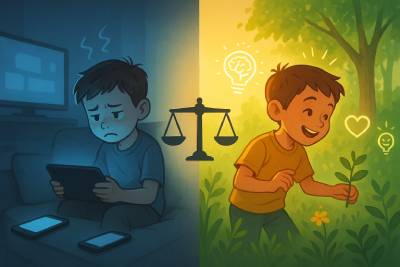 The relationship between screen time and children’s health has evolved into a complex field of study, with emerging research highlighting both potential risks and protective factors. 🔬 Studies from 2024-2025 have revealed that excessive screen time is linked to increased anxiety, depression, and attention difficulties in young people, while also identifying “green time” (time spent in nature) as a powerful protective factor that may buffer these negative effects.
The relationship between screen time and children’s health has evolved into a complex field of study, with emerging research highlighting both potential risks and protective factors. 🔬 Studies from 2024-2025 have revealed that excessive screen time is linked to increased anxiety, depression, and attention difficulties in young people, while also identifying “green time” (time spent in nature) as a powerful protective factor that may buffer these negative effects.
Research by Schwarz et al. (2025) found that parental screen time in the presence of infants was associated with slower motor, language, and social-emotional development, while Wang et al. (2024) demonstrated that adolescents with greater nature exposure were significantly less likely to develop internet addiction. 🌳 These findings suggest that the balance between digital engagement and natural environments plays a critical role in children’s development.
Fast-paced audiovisual media may be particularly concerning for young developing brains. ⚡ Studies suggest that rapid scene changes and high stimulation content may affect children’s attention spans and executive functioning. Experimental studies using mouse models have confirmed that excessive sensory stimulation leads to cognitive and behavioral changes similar to attention problems in humans. While researchers can’t prove causation directly in children (since such experiments would be unethical), there’s growing evidence that early overstimulation through screens might contribute to attentional difficulties later in life.
Equally important are recent discoveries about the potential of green spaces to mitigate screen time’s effects. 🌲 A 2024 study by Liu et al. demonstrated that for economically disadvantaged students, higher levels of school greenness were significantly related to decreased depressive symptoms, particularly among those with moderate screen use. Similarly, research from the University of Michigan highlighted how neighborhood environments with adequate green space are critical to the success of programs designed to reduce children’s screen time.
Table of Contents
The Psychological Impact of Screen Time on Children 🧠
The relationship between screen time and psychological wellbeing in children is nuanced and continues to evolve as research advances. Current evidence suggests several important considerations:
Attention and Cognitive Development 🎯
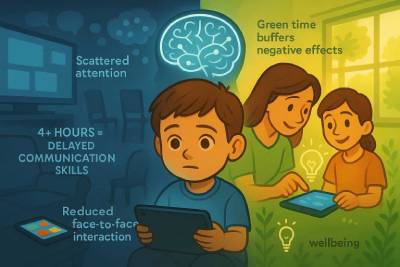 Excessive screen use, particularly content with rapid scene changes and high stimulation, may affect children’s attention spans and executive functioning. A 2024 study published in the Journal of the American Medical Association Pediatrics found that children exposed to more than four hours of screen time per day showed delays in communication and problem-solving skills at ages 2 and 4 years.
Excessive screen use, particularly content with rapid scene changes and high stimulation, may affect children’s attention spans and executive functioning. A 2024 study published in the Journal of the American Medical Association Pediatrics found that children exposed to more than four hours of screen time per day showed delays in communication and problem-solving skills at ages 2 and 4 years.
Recent research from Hello Pediatrics (2024) confirms that “rapidly changing content and fast-paced media can reduce attention span and concentration, impacting academic performance.” Children accustomed to quick changes in online content often struggle to focus on traditional classroom activities that require sustained attention.
For children younger than 18 months, studies have shown that even background television can have negative effects on language development. 👶 As noted by Dr. Michelle Yang of CHOC, “When there was background TV, parents tended to talk less. They tended to be more passive in their interactions with their children when the TV was on.” This reduced parent-child interaction is a key mechanism through which screen time may impact early cognitive development.
Emotional Wellbeing 😊
According to recent research, children who spend excessive time on screens are more likely to show symptoms of depression and anxiety compared to moderate users. 😟 A 2024 Swiss study involving 844 children and adolescents found that higher screen times were significantly associated with increased mental health problems, while higher green times were associated with reduced mental health problems.
The quality of content consumed, rather than just quantity, plays a crucial role in determining psychological impacts. 🎮 Educational programming with appropriate pacing has been shown to have neutral or even positive effects on child development when limited to recommended durations.
A March 2025 research digest from the Children & Nature Network revealed that green time could potentially buffer negative mental health consequences of high screen time, suggesting that nature may be an under-utilized public health resource for promoting psychological wellbeing in children in our increasingly digital era. 🌿
Social Development 👥
Screen time can either enhance or hinder social development depending on how it’s used. Video chatting with family members can strengthen bonds for young children, while collaborative gaming with positive content may build teamwork skills in older children.
However, excessive screen use often displaces crucial face-to-face interactions that build empathy and communication skills. 🗣️ A 2024 study published in the Journal of Occupational Science found that higher screen time was associated with less time spent in play activities, which are critical for developing social skills and emotional regulation.
The displacement of peer play by screen time has been linked to developmental concerns in toddlers. As children spend more time with screens, they have fewer opportunities to practice real-world social interactions, potentially limiting their ability to develop empathy, cooperation, and conflict resolution skills.
Individual Differences: Why Some Children Are More Vulnerable 🔍
Not all children respond to screen time in the same way. Emerging research suggests several factors that influence how screen time affects individual children:
Genetic and Neurological Factors 🧬
Studies in developmental neuroscience indicate that children with certain genetic profiles may be more susceptible to the effects of screen time. Research published in Nature Human Behaviour in 2024 suggests that variations in dopamine receptor genes influence how rewarding and potentially habit-forming screen activities can be for different children.
Children with attention disorders like ADHD may experience more pronounced effects from highly stimulating content. 🔄 A 2024 study in Frontiers in Psychiatry found that ADHD and screen time have a bidirectional relationship—children with ADHD tend to use screens more frequently, and excessive screen time may exacerbate existing attention symptoms.
Temperament and Sensory Processing 🔊
Children with different temperaments respond differently to screen-based stimulation. Highly sensitive children or those with sensory processing sensitivities may become overwhelmed by fast-paced or loud content, potentially leading to dysregulation after screen exposure.
As Dr. Michael Rich, Director of the Center on Media and Child Health at Boston Children’s Hospital, explains: “We need to move from asking how much is too much to asking how particular children respond to particular content in particular contexts.”
The Green Time Factor: Nature as a Buffer 🌳
A groundbreaking development in screen time research is the growing evidence that “green time” (time spent in nature) may provide a protective effect against the negative impacts of screen use in children.
The Protective Effects of Nature Exposure 🌱
Multiple studies published in 2024-2025 have demonstrated that regular access to natural environments can help mitigate the negative effects of screen time on children’s mental health and cognitive functioning:
Wang et al. (2024) found that adolescents with greater nature exposure were significantly less likely to develop internet addiction. Liu et al. (2024) showed that higher levels of school greenness were related to decreased depressive symptoms in children. Deyo, Wallace & Kidwell (2024) demonstrated that time in nature may reduce mental health issues associated with screen time in college students.
Inequity in Green Space Access ⚖️
A critical aspect of the screen time and green time relationship is the unequal access to natural environments. Research from the University of Michigan (2025) found that neighborhood green spaces significantly impact the effectiveness of programs designed to reduce children’s screen time.
According to lead researcher Ian-Marshall Lang, “Both our study and national data show green space is less common in communities with higher Hispanic and Black populations. These unfair differences in green space access might explain why community programs and policies are less effective in reducing screen time among different racial and ethnic groups.”
This suggests that addressing inequities in green space access should be a key component of comprehensive strategies to manage children’s screen time.
Balancing Digital and Natural Experiences ⚖️
Research now suggests that rather than simply limiting screen time, parents and educators should focus on ensuring children have adequate exposure to natural environments. According to the 2025 Research Digest from the Children & Nature Network, there are several evidence-based recommendations:
- Encourage frequent time in nature as an intervention to protect against unhealthy screen habits 🏞️
- Use nature-immersion experiences such as outdoor adventure programs to provide time away from screen-dependent lifestyles 🏕️
- Increase efforts to “green” schoolyards to protect against screen time’s adverse mental health impacts 🌱
- Ensure equitable access to greenspace to reduce racial and ethnic disparities in screen time 🌿
- Parents should limit their own screen time and spend more time in nature with their children 👨👩👧👦
Creating a Balanced Digital Environment 🧘♀️
Establishing healthy screen habits requires a thoughtful, intentional approach that considers each child’s unique needs while setting appropriate boundaries.
Age-Appropriate Guidelines 📏
The American Academy of Pediatrics provides age-specific recommendations:
- Under 18 months: Avoid screen media other than video-chatting 👶
- 18-24 months: Limited high-quality programming with adult co-viewing 👨👩👧👦
- 2-5 years: No more than 1 hour per day of high-quality content 🕐
- 6+ years: Consistent limits on time and content types ⏰
These guidelines should be adapted to fit individual children’s needs and family circumstances. The Canadian Paediatric Society’s 2023 updated statement emphasizes four evidence-based principles: minimizing, mitigating, mindfully using, and modeling healthy use of screens.
Quality Over Quantity ⭐
When evaluating children’s screen time, the content’s quality is as important as the duration. Educational programming with appropriate pacing, clear storylines, and positive messages can support learning and development.
Parents should prioritize:
- Interactive over passive content 🎮
- Educational over purely entertainment-focused media 📚
- Content that encourages creativity and problem-solving 🧩
- Age-appropriate material that aligns with developmental stage 🧒
Recent research has found that touchscreen interactions may be more beneficial than passive viewing. A meta-analysis published in 2022 found that young children can learn from touchscreens, particularly when they physically interact with the content.
Creating Tech-Free Zones and Times 🚫📱
Establishing tech-free zones and times helps maintain healthy boundaries around device use. Consider implementing:
- Device-free meals to promote family connection and conversation 🍽️
- Screen-free bedrooms to support healthy sleep patterns 🛏️
- Tech-free periods before bedtime (ideally 1-2 hours) to prevent sleep disruption 😴
- Regular outdoor play and physical activity times without devices 🏃♂️
Research demonstrates that blue light from screens can disrupt melatonin production, making consistent screen-free time before bed particularly important for healthy sleep patterns. A 2024 study found that excessive screen use before bedtime was associated with sleep difficulties in children, which can further impact cognitive functioning and emotional regulation.
Practical Strategies for Healthy Digital Habits 🔧
Implementing effective screen time management requires consistent, practical approaches that work in real-world family contexts.
Modeling Healthy Technology Use 👨👩👧👦
Children learn by example, making parental modeling one of the most powerful tools for establishing healthy digital habits. According to research from Common Sense Media, children whose parents demonstrate balanced technology use are more likely to develop similar patterns.
The 2025 “Screen-free till 3” intervention study found that parental screen time in the presence of their children was related to slower motor, language, and social-emotional development. Conversely, children whose parents did not use devices around them demonstrated stronger developmental patterns.
Practical modeling strategies include:
- Putting devices away during family meals and activities 🍽️
- Following the same rules you set for children 📏
- Demonstrating mindful technology use by explaining when and why you’re using devices 🧠
- Taking regular breaks from screens and engaging in diverse offline activities 🎨
The Screen Time Management System 📊
For a structured approach to balancing digital engagement, a comprehensive framework includes:
- Assessment: Evaluate current screen habits through tracking and observation 🔍
- Goal-Setting: Establish realistic, age-appropriate targets for both time and content 🎯
- Structure: Create consistent routines around when screens are and aren’t used 📅
- Alternatives: Develop engaging non-screen activities that fulfill similar needs 🎭
- Monitoring: Use parental controls and open conversations about digital citizenship 👁️
Teaching Digital Literacy and Critical Thinking 🤔
Beyond simply limiting screen time, helping children develop critical thinking skills about media is essential. The U.S. Department of Education emphasizes that digital literacy education should begin in early childhood and continue throughout development.
Key components include:
- Discussing how media messages are created and why 🎬
- Questioning the credibility of online information 🧐
- Understanding digital privacy and security 🔒
- Recognizing advertising and marketing strategies 💰
- Developing awareness of how screen use affects mood and behavior 😊😟
The Connection Between Screen Time, Focus, and Behavior 🔄
Understanding how screen exposure influences children’s attention and behavior can help parents make informed decisions about technology use.
The Stimulation Factor ⚡
Highly stimulating content with rapid scene changes, bright colors, and loud sounds can lead to what researchers call the “fast-paced media effect.” Studies suggest that after exposure to such content, some children show temporary decreases in executive function skills like impulse control and sustained attention.
This effect is particularly pronounced in younger children, whose developing brains are more susceptible to external stimulation patterns. A longitudinal cohort study of toddlers found that screen media use was significantly associated with aggressive behavior and overall externalizing problems months later.
The Displacement Hypothesis 🔄
According to recent research, excessive screen time often displaces activities crucial for developing attention and self-regulation, including:
- Free play and exploration 🎮
- Face-to-face social interaction 👥
- Physical activity and outdoor time 🏃♀️
- Reading and hands-on learning experiences 📚
A 2024 study published in the Journal of Occupational Science found that as children’s screen time increased, their engagement in play decreased significantly. Since play is a critical occupation for children’s development of essential life skills, this displacement may have long-term consequences for cognitive and social-emotional growth.
Recognizing Warning Signs ⚠️
Parents should be attentive to potential signs that current screen habits may be affecting a child’s functioning:
- Difficulty transitioning away from screens without significant distress 😫
- Decreased interest in non-screen activities previously enjoyed 😐
- Changes in sleep patterns, including difficulty falling or staying asleep 😴
- Irritability, mood swings, or behavioral challenges after screen use 😠
- Declining academic performance or attention in school 📉
Early recognition of these patterns allows for timely adjustments to screen management approaches.
Tools for Success in Different Settings 🛠️
Effective screen time management requires thoughtful approaches across all the environments where children spend time.
Home Environment Strategies 🏠
Creating a home that supports balanced technology use involves both physical setup and consistent routines:
- Centralized Device Storage: Designate a specific location for storing and charging devices when not in use, preferably in common areas rather than bedrooms 🔌
- Visual Schedules: Use charts or timers to make screen time limits concrete and predictable ⏲️
- Technology-Free Activities Center: Create engaging alternatives with easily accessible craft supplies, books, games, and outdoor equipment 🎨
- Parental Controls: Utilize built-in device settings and specialized apps to manage content access and usage duration 🔒
School and Educational Settings 🏫
As digital learning becomes increasingly integrated into education, balanced approaches include:
- Purposeful Technology Integration: Using screens specifically for educational objectives rather than as default activities 🎯
- Movement Breaks: Implementing regular physical movement between screen-based learning segments 🏃♂️
- Blended Learning Models: Combining digital and hands-on approaches for diverse learning experiences 🔄
- Digital Wellness Education: Teaching students to recognize their own needs for screen breaks and self-regulation 🧘♀️
The 2024 study by Liu et al. found that higher levels of school greenness were significantly related to decreased depressive symptoms in students, highlighting the importance of natural elements in educational environments where screen-based learning is common.
Special Considerations for Different Age Groups 👶👧👦👩
Screen time management strategies should evolve as children develop through different developmental stages.
Early Childhood (0-5 years) 👶
During these formative years when brain development is most rapid, limiting screen exposure is particularly important. The World Health Organization recommends:
- Prioritizing face-to-face interaction and hands-on exploration 👨👩👧👦
- If using screens, choosing slow-paced, interactive content 🐢
- Always co-viewing and discussing content 👥
- Ensuring screen time never replaces physical activity, sleep, or responsive interaction 🏃♀️
Recent research indicates that children under 2 years who spend two or more hours a day in front of a screen are up to six times more likely to experience language delays. These risks are even greater if screen time begins before 12 months of age.
School Age (6-12 years) 🧒
As academic demands and social connections increasingly involve technology:
- Establish clear boundaries between entertainment and educational screen time 📚
- Teach digital citizenship and online safety 🛡️
- Encourage balance with non-digital hobbies and sports ⚽
- Start conversations about how media content makes them feel 🗣️
- Build critical thinking about advertising and media messages 🤔
Recent data indicates that about two-thirds of children ages 6 to 17 exceed the recommended limit of two hours of screen time each day. Strategies for this age group should focus on creating alternatives that are equally engaging, such as access to green spaces and structured physical activities.
Adolescence (13+ years) 👩
With increased independence, the focus shifts:
- Collaborate on technology agreements rather than imposing rules 🤝
- Discuss digital footprints and long-term implications of online behavior 👣
- Address specific concerns like social media comparison and online relationships 📱
- Promote self-monitoring of screen habits and their effects on mood and productivity 🧠
- Maintain open communication about online experiences 🗣️
The 2024 study by Wang et al. found that adolescents with greater nature exposure were significantly less likely to exhibit internet addiction, suggesting that encouraging outdoor activities remains important even as teens gain more autonomy in managing their screen time.
Read more at “Screen Time Rules for Kids: Age-by-Age Guide for Parents“.
Looking Forward: Balanced Digital Citizens 🌍
As technology continues to evolve rapidly, helping children develop internal regulation around screen use becomes increasingly important. The goal isn’t to eliminate technology—which will be central to their future lives and careers—but to foster mindful, intentional users who can harness digital tools without being controlled by them.
Research from the Digital Wellness Institute suggests that children who develop healthy technology habits early are better positioned to:
- Use digital tools productively in educational and professional contexts 💼
- Maintain meaningful in-person relationships alongside digital connections 👥
- Recognize and mitigate potential negative impacts of technology on wellbeing 🧘♀️
- Adapt to changing technological landscapes with resilience 💪
By approaching screen time management through an individualized, balanced lens that incorporates ample green time, parents and educators can help children thrive in our digital world while supporting their cognitive, emotional, and social development. 🌱💻
Frequently Asked Questions ❓
Q: Is all screen time harmful for children? 🤔
A: No, not all screen time is created equal. High-quality, age-appropriate, educational content used in moderation can be beneficial, especially when adults co-view and discuss the material with children. Recent research distinguishes between different types of screen time: educational (learning apps, research), recreational (videos, games), and social (communication platforms). The potential for negative impacts increases with excessive use, inappropriate content, or when screen time displaces other important developmental activities like physical play, face-to-face social interaction, and adequate sleep.
Q: How does green time help balance the effects of screen time? 🌳
A: Research from 2024-2025 shows that green time (time spent in nature) may buffer the negative effects of screen time on children’s mental health and cognitive development. Studies have found that children with greater nature exposure show reduced anxiety, depression, and internet addiction compared to peers with similar screen time but less nature exposure. Green spaces provide opportunities for physical activity, stress reduction, and multi-sensory engagement that can counterbalance the sedentary and often overstimulating nature of screen activities.
Q: How do I know if my child is getting too much screen time? 📱
A: Watch for warning signs including: difficulty transitioning away from screens without significant distress, decreased interest in previously enjoyed non-screen activities, changes in sleep patterns, irritability or behavior problems after screen use, or complaints about boredom when not using devices. If you observe these patterns, it may indicate a need to adjust current screen habits.
Q: Should screen time rules be the same for all children in a family? 👨👩👧👦
A: While consistency is important, children have different temperaments, sensitivities, and developmental needs that may warrant individualized approaches. Older children typically require different guidelines than younger siblings. Recent research emphasizes that children respond differently to screen content based on individual factors including genetic predispositions, temperament, and existing conditions like ADHD. The key is to be transparent about why different rules exist for different family members while maintaining core principles about healthy media use.
Q: How can I reduce screen time without constant battles? ⚔️
A: Focus on the positive by offering engaging alternatives rather than simply taking screens away. Establish clear, consistent routines around when devices are and aren’t used, involve children in creating technology agreements, use visual timers to make limits concrete, and most importantly, model healthy technology habits yourself. Current research suggests that access to green spaces and nature-based activities can make screen time reduction efforts more successful, as they provide compelling alternatives that meet children’s needs for stimulation, exploration, and enjoyment.
Q: What about educational apps and games—do these count as screen time? 🎮
A: Yes, educational content still counts as screen time from a developmental perspective. While the content quality matters significantly, the medium itself—screens—still involves the same visual processing, potential for overstimulation, and displacement of hands-on experiences. Recent research indicates that interactive educational content may have more benefits than passive viewing, especially when parents co-engage with children. Educational screen time is best used as a supplement to, not replacement for, real-world learning experiences.
Q: How does screen time before bed affect children? 😴
A: Evening screen exposure can significantly disrupt sleep through multiple mechanisms: the blue light emitted suppresses melatonin production (the hormone that regulates sleep), stimulating content can increase alertness and physiological arousal, and devices may delay bedtime through the “just one more” phenomenon. Recent studies confirm that these sleep disruptions can have cascading effects on mood, attention, and learning the following day. Research consistently shows that screen-free time (ideally 1-2 hours) before bed improves both sleep quality and quantity in children.
Author:
 | Lionel Thomas Father, Gamer and Founder with a Passion for Health, AI, Environment and Gamification of Life. |
Author Tool:
- Claude (Content Enhancements & Research)
- GSpeech (Audio by AI)
- Other Tools (AI)...
Artists:
- Lionel Thomas using DALL-E 3 [AI Generated] (Header, Content)
References:
Screen time and green time
Children and Nature
https://www.childrenandnature.org/resour...
Summary:
The document presents comprehensive research on the relationship between screen time (digital device usage) and green time (time spent in nature) for children.
Key findings include:
Research consistently shows that excessive screen time is linked to negative outcomes for children's mental health, neurodevelopment, and nature connectedness. In contrast, green time promotes wellbeing and healthy development, with evidence suggesting it may moderate or buffer the negative effects of screen time.
Several studies demonstrate that higher screen time correlates with poorer psychological outcomes (depression, anxiety, stress), while green time is associated with positive mental health and cognitive functioning. For example, a 2024 study found that college students with more screen time experienced increased anxiety and depression, while those with more green time showed lower stress levels.
The document offers seven evidence-based recommendations:
- Use frequent nature time to protect against unhealthy screen habits
- Implement outdoor adventure programs as screen-free interventions
- Green schoolyards to mitigate screen time's mental health impacts
- Ensure equitable access to greenspace to reduce screen time disparities
- Encourage parents to limit their own screen use and increase family nature time
- Promote family engagement in nature-based activities
- Thoughtfully integrate technology to enhance nature connection
Recent research (2025) shows that parental screen use around infants correlates with slower development, while nature exposure appears protective. The document also explores how technology, when designed with youth input and nature-centered approaches, can potentially support rather than hinder children's engagement with the natural world.How early media exposure may affect cognitive function
National Library of Medicine
https://pubmed.ncbi.nlm.nih.gov/30275319...
Summary:
This examines the potential relationship between early childhood exposure to fast-paced audiovisual media and the development of attention deficit hyperactivity disorder (ADHD). The text highlights that ADHD diagnoses have increased approximately 30% over the past two decades, prompting investigation into environmental factors that might contribute to this rise.
Key points include:
- Observational human studies have found associations between exposure to fast-paced television during the first three years of life and subsequent attention problems in childhood.
- Due to ethical constraints preventing experimental studies in humans, researchers have developed mouse models of excessive sensory stimulation (ESS) to investigate causal relationships.
- These experimental animal studies have confirmed that ESS leads to cognitive and behavioral deficits similar to attention problems in humans.
- With screens everywhere in children's lives today, these findings raise serious public health concerns. If early media exposure truly affects brain development and attention as the research suggests, this could impact millions of children's healthy development and future success.
The research suggests that early sensory overstimulation, particularly through rapid audiovisual media, might be one environmental factor contributing to attentional difficulties, though the observational nature of human studies prevents definitive causal conclusions.
Screen time and mental health in college students: Time in nature as a protective factor
National Library of Medicine
https://pubmed.ncbi.nlm.nih.gov/36796079...
Summary:
This study looked at college students and found that more time on phones and tablets was linked to higher levels of anxiety, depression, and stress. Time spent outdoors in nature ("green time") was linked to lower stress and depression.
The most interesting finding was how nature and screens interacted. For students who rarely spent time outdoors, their mental health symptoms stayed high regardless of screen time. But for students who spent average or above-average time in nature, those with lower screen time had much better mental health.
This suggests that simply reducing screen time might not improve mental health if students don't also spend time in nature. The combination of less screen time and more nature time appears to be most beneficial for college students' mental health.
In practical terms, this means college mental health programs might be more effective if they encourage students to both reduce screen use AND spend more time outdoors, rather than just focusing on cutting back on screens alone.Neighborhood environments underpin screen time intervention success in children: Evidence from a study of greenspace and community programming across 130 US communities
National Library of Medicine
https://pubmed.ncbi.nlm.nih.gov/39217807...
Summary:
This study looked at how having parks and natural areas in neighborhoods affects programs designed to reduce children's screen time. After examining data from 4,598 US children, researchers discovered something important:
Programs to reduce screen time worked well in neighborhoods with lots of green space, but had little effect in areas with minimal or moderate green space. The researchers also found that neighborhoods with higher percentages of Black and Hispanic residents typically had less access to green spaces.
This suggests that when we implement screen time reduction programs without considering who has access to parks and nature, we might unintentionally make existing inequalities worse. Kids need places to play outside as alternatives to screens, and when those spaces aren't available, simply telling families to reduce screen time doesn't work as effectively.
The key takeaway is that addressing screen time in children requires ensuring all neighborhoods have adequate green spaces where children can play, not just implementing screen time reduction programs.The association between green space around schools, screen time for entertainment, and adolescent depressive symptoms: A nationwide study from China
National Library of Medicine
https://pubmed.ncbi.nlm.nih.gov/39374752...
Summary:
This study, conducted in China with nearly 23,000 teenagers, looked at how green space around schools and screen time together affect mental health.
Researchers found that having more trees and plants around schools (measured within 200m, 500m, and 1000m of the school) helped protect against depression - but only for teens who spent less than 2 hours per day on recreational screen time. For teens who spent more than 2 hours on screens daily, the green space benefits disappeared.
This protective effect of green space was especially strong for students from lower-income families. When teenagers from economically disadvantaged backgrounds had both limited screen time and access to greener school environments, they showed significantly fewer symptoms of depression.
The findings suggest that creating greener school environments could be a powerful way to address mental health inequities, particularly when combined with reasonable limits on recreational screen time.An umbrella review of the benefits and risks associated with youths' interactions with electronic screens
National Library of Medicine
https://pubmed.ncbi.nlm.nih.gov/37957284...
Summary:
This large-scale review analyzed 102 meta-analyses (combining 2,451 studies with nearly 2 million participants) to understand how screen use affects children and adolescents. The researchers found 43 effects that were statistically reliable.
For education, the results were mixed. Screen time generally showed a small negative relationship with literacy skills (r = -0.14), but interestingly, when parents watched screens with their children, the effect became positive (r = 0.15). This suggests that how screens are used matters as much as how much they're used.
For health outcomes, several small negative associations were found. For example, social media use was linked to higher depression symptoms (r = 0.12). Most of these relationships were small to moderate in size.
Important limitations include high variability between studies and potential bias in most of the meta-analyses reviewed. This suggests we should be cautious about making sweeping conclusions.
The researchers recommend that parents and policymakers carefully consider both potential benefits and harms of specific types of screen use, rather than treating all screen time as uniformly good or bad. The context and content of screen use appear to matter significantly.Screen Time, Nature, and Development: Baseline of the Randomized Controlled Study "Screen-free till 3"
National Library of Medicine
https://pubmed.ncbi.nlm.nih.gov/39439363...
Summary:
This German study, which began in 2022, is examining the effects of screen time on very young children, with 4,021 parents participating in the initial survey. The research revealed some concerning patterns:
Many parents showed signs of problematic internet use - 16.7% of mothers and 31% of fathers scored high enough on the CIUS test to indicate an internet-related disorder. Parents whose children used screens early had significantly higher CIUS scores than parents whose children had no screen time.
The study found that children's development was negatively associated with parental screen time, suggesting that when parents use screens more around their young children, it may impact development. Conversely, time spent in nature was positively associated with development.
A key finding was that parents' screen habits directly influence their children's exposure to screens. The study confirms what many experts have suspected: heavy screen use by parents leads to more screen time for their young children, potentially affecting early development.
Based on these preliminary findings, the researchers are conducting a three-year intervention where 2,581 pediatric practices are encouraging parents to keep children completely screen-free until age 3.








 Snacks
Snacks Water
Water Eye Sight
Eye Sight Hearing
Hearing














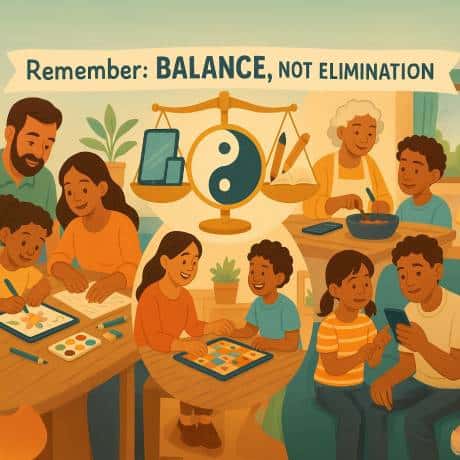

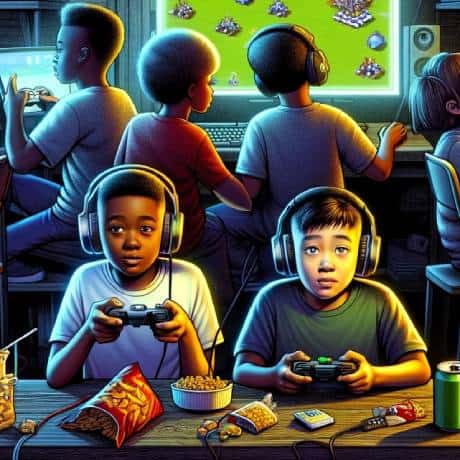





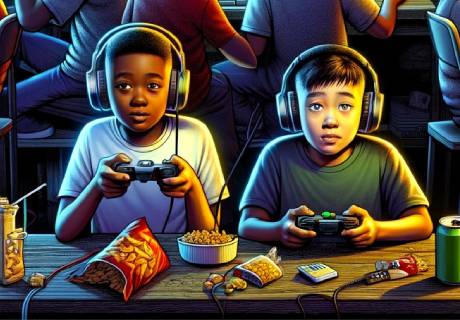
 Screen Time
Screen Time Play Sports
Play Sports


